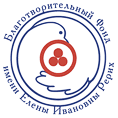On the Trustworthiness of Certain Provenances of Paintings by Nicholas Roerich
Galina V. Daruze. Donations
Over the past two years, the catalogues of Christie’s and Sotheby’s auction houses have been demonstrating some strange tendencies regarding the data on the origins of paintings of Nicholas Roerich. As auction houses always acknowledge Daniel Entin, Director of the Roerich Museum in New York, and Gvido Trepsa, Senior Researcher of the Museum, for their assistance in preparing this data, we address our concerns mainly to these two gentlemen. We address them both as our colleagues who must follow the principles of the Code of Ethics for Museums developed by the International Council of Museums (ICOM) and as custodians of the heritage of the Roerich family, to the memory of whom we all have certain moral obligations as to the Founders of our museums.
According to collection acquisition principles, formulated in the ICOM Code, all provenance information published by auction holders must be very thoroughly checked and proved with documentary evidence. Our preliminary studies of the provenances of Nicholas Roerich’s canvases The Last of Atlantis, Mongol Tsam, and Tsaidam have shown the following results.
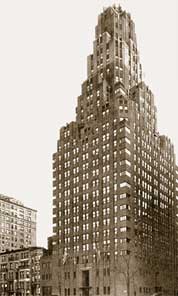 | |
The official catalogue of the Nicholas Roerich Museum dated 1930 featured all the three paintings under definite numbers, but with the abbreviation “L.E.”, or “Loan Exhibition”, meaning a painting loaned for an exhibition. Nicholas Roerich clearly defined the status of such items in his note to the lawyers with a copy to Sina G. Lichtmann (Fosdick) [1], kept in her archives that have long been the object of Mr. Entin’s research. In this note Nicholas Roerich stated: “I loaned the collection of paintings created in Asia from 1923 to 1929 to the Museum for the amount determined by the Council of Trustees as two hundred thousand dollars”, and due to the absence of such amount, the collection “remains the property of the Establishment” [2] as a debt that the artist was not going to recall. Besides, according to the Declaration of 1929, signed by all Founders of the museum including the Horch couple, the entire collection of the Museum was donated to the nation of the United States in 1929. Still, the provenances never contained these facts nor had they information on the status of the temporary sojourn of several paintings and on their owners – Nicholas and Helena Roerich. The provenances are lacking references to the official catalogue of the Nicholas Roerich Museum of 1930. Unlike museum archival lists which Mr. Trepsa prefers referring to, the official catalogue of 1930 was published, and Nicholas Roerich himself and researchers of his creative heritage always considered this catalogue as an important source document and a legal paper.
In this regard, the confusing provenance of Nicholas Roerich’s work Not Gone Yet in Christie’s Catalogue 2008 arouses righteous indignation and perplexity. The ownership of the painting by Nicholas Roerich Museum in New York is not mentioned at all disregarding the facts that the canvas created in 1917 was listed under No. 38 in the museum catalogue of 1930 among the permanent display items and was viewed by Nicholas Roerich as the “unconditional property of the Museum” [3] as he wrote in 1935. The connection of the painting to the museum is mentioned only in the very end of the literature section. How odd! Still the acknowledgements for the provenance go to Gvido Trepsa, Senior Researcher at the Nicholas Roerich Museum, New York. It is hard to imagine that the staff of the American museum has not read its own archives and publications.
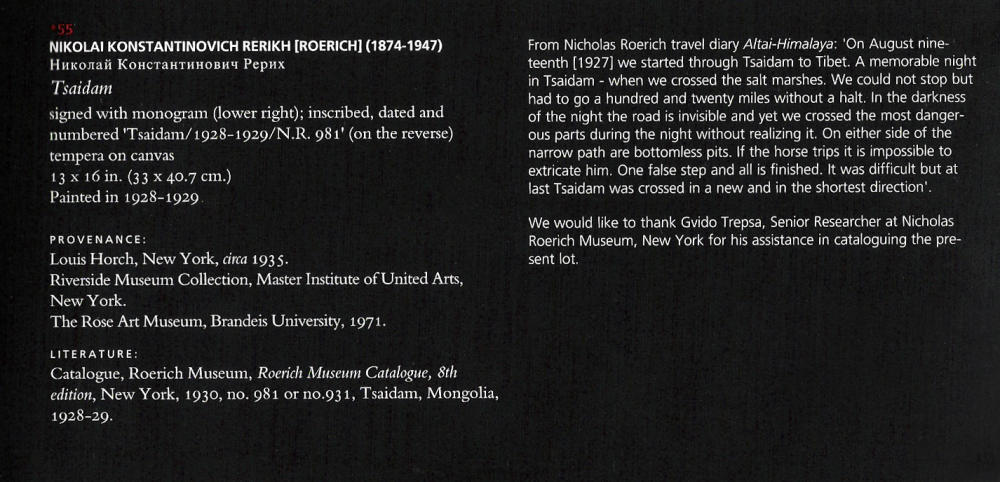 |
We raise the same complains against the provenance of the canvas Tsaidam. In the Roerich Museum Catalogue of 1930, it is listed with the abbreviation “L.E.”. Not a single word in the provenance reveals this fact – the existence of this masterpiece begins with ... Mr. Horch (!). He is recorded as the first owner of the painting. A rare case for Christie’s catalogues: the provenance even indicates the exact year when Mr. Horch seized the painting – 1935! By far more surprising about this is that the court judgment on the issue of the ownership of paintings which used to be the property of the Nicholas Roerich Museum in New York had not been delivered in 1935. And as is well known, in June, 1935, in spite of the Declaration and Nicholas Roerich’s appeals “to preserve with great care the sanctity of this donation that marks a historic day in the Culture of America”, Louis Horch began his barbarian plunder of the Museum.
One cannot help wondering on what grounds and for what reasons “specialists” of the present-day Roerich Museum in New York regardless of existing documents arbitrary remove from the history of Nicholas Roerich’s paintings the fact that once they were part of the museum collection donated to the American nation in 1929?
Finally, why the names of Nicholas Roerich, the rightful owner, and Helena Roerich, whose ownership rights for the paintings the artist always proved in his letters to American colleagues, are omitted more frequently? In March, 1936, Nicholas Roerich asked his colleagues to remind the lawyers: “my paintings have always belonged to H.I. (Helena Roerich – Galina Daruze)” [4]. It is unlikely that researchers of the Roerich Museum in New York are unaware of the contents of the documents we quote – all of them are kept in the museum archives and were addressed to Mrs. Fosdick. Why then preparing lot descriptions for auction catalogues do they distort and obscure facts about the history, origin and ownership of paintings that are worth hundreds of thousands and millions of dollars each? It is common knowledge that the contents of a provenance is of paramount importance for the legal status of a lot, as well as for the reputations of the seller and the buyer. Are they, perhaps, ashamed of their own past, of the “provenance” of the Horches’ collection? Its filth and meanness was disclosed by publications of the International Center of the Roerichs – the complete collection of Helena Roerich’s letters, diaries of Nicholas Roerich and other archival materials. If they are ashamed, then they should stand by the truth to purify their personal and professional reputations.
Let us remind the American museum specialists providing art traders with identifications and provenances for highly expansive canvases of Nicholas Roerich of the two paragraphs from the UNESCO Code of Ethics for Museums. The first paragraph says that museum collections and items “have a character beyond that of ordinary property”. The second one reads that acquiring an object buyers should know its real provenance and must undertake a due diligence search to hold a valid title for its lawful ownership.
In this regard, it is worth revising Nicholas Roerich’s assessment of Mr. Horch and his instructions to the American staff in his letter to Mrs. Fosdick in March, 1941: “The appalling fraud destined to be revealed sooner or later should be asserted at all times, should be kept before the eye of the public opinion. Any publicity, every piece of truth strengthens our common position. <...> Indeed, there has never been such a case in the history of Culture and the history of Art, and it should have the paramount importance in the memorandum” [5].
It is worth while recalling the letter of Helena Roerich dated 22 October, 1935 [6] , addressed to F. Grant and the Lichtmanns and kept in the archives of the Museum by name of Nicholas Roerich in Moscow. It reads: “If we divide the amount Mr. Horch speaks of by the number of paintings acquired by the Museum, then the price of a painting will not exceed two hundred and fifty dollars!! <…> And there are people who will be [discussing and pondering] the miserable amount paid for the paintings!! Oh how much I await an enlightened voice to say to Mr. Horch: ‘Shame on you, put away your checks. Exactly they are your accusers’. Of course, this voice will be raised, and it will sound particularly powerfully in the pages of the History of Culture. <…> Thus, whereas N.K. is ashamed of uttering the miserable amount he received from Mr. Horch, the ignoramus is crying it out laud boasting about his generosity. For if it had not been for the ideological development, N.K. would have never consented to that miserable price… <…> The Museum laid the foundation of the entire social position of Mr. Horch which is being so actively destroyed at present” [7].
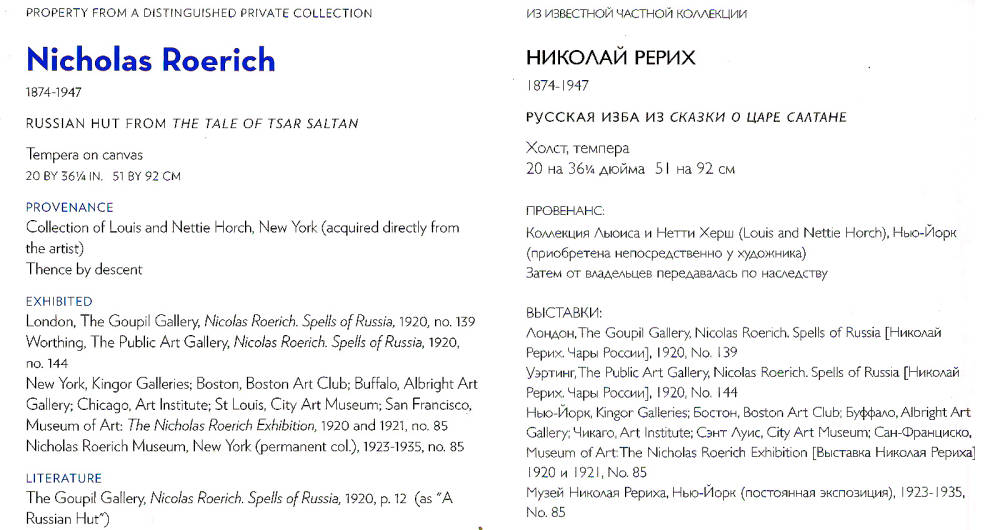 |
The lack of truthful information regarding the ownership history of Nicholas Roerich’s paintings on the world market of art auctions demonstrates the low level of ethics and professionalism of people entitled by history and destiny to protect and preserve the Great Gift – the heritage of Nicholas Roerich, an outstanding Artist and Humanist. One should not also forget that the building and part of the collection of the Roerich Museum in New York originated solely owing to Catherine Campbell’s donations, who acted on Helena Roerich’s request to buy out part of the paintings of Nicholas Roerich after the Horches’ betrayal. Accepting the gifts related to the name and the heritage of the Roerichs, no matter where it happens, we become custodians of the planetary heritage and must solemnly remember our eternal and urgent duty to the Donators.
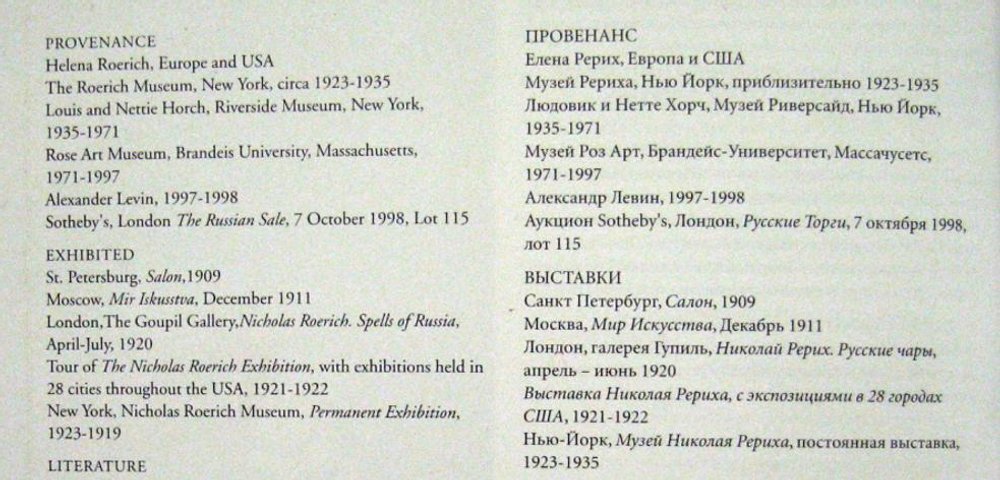 |
P.S. At the same time, a flawlessly composed provenance of Nicholas Roerich’s canvas The Treasure of the Angels from the collection of Vishnevskaya-Rostropovich (Sotheby’s Catalogue 2007) is an illustration of a scrupulous approach to a specialist’s work. Year by year, it traces all owners of the painting, as well as all museums where it has been displayed. This provenance can be considered as a high standard. Yet specialists from the Nicholas Roerich Museum in New York have nothing to do with its preparation.
Published in the magazine “Cultura i Vremya” (“Culture and Time”) No. 3, 2008.
1 Until 1939, Sina G. Fosdick had the name of her first husband Mr. Lichtmann.
2 Roerich, N.K. Note on the paintings of Nicholas Roerich dated 24 October 1935. // Roerich, H.I. Letters. Vol. 4. Moscow: ICR, 2002. P. 457-458.
3 Roerich, H.I. Letters. Vol. 3. Moscow: ICR, 2001. P. 613.
4 Roerich, H.I. Letters. Vol. 4. P. 112.
5 Roerich, N.K. Pages of the Diary. Vol. 2. Moscow: ICR, 1996. P. 387.
6 We refer to the letter the original of which must be kept at the Nicholas Roerich Museum in New York. The ICR keeps the second copy of it.
7 Roerich, H.I. Letters. Vol. 3. P. 613.

